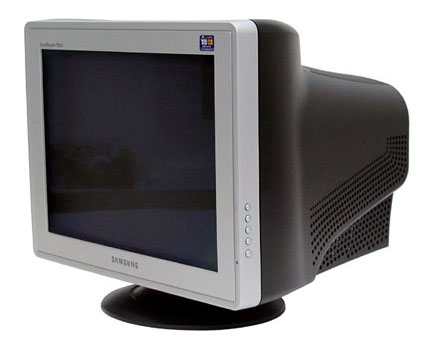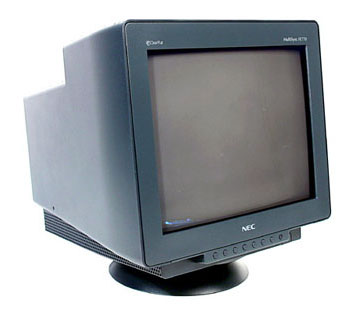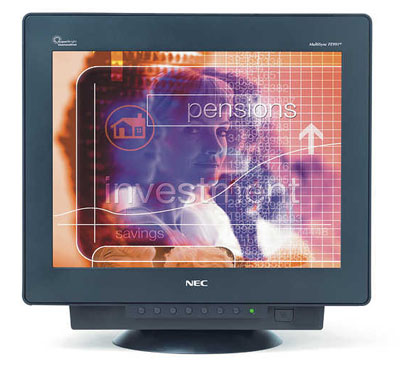Buyer's Guide - Entry Level, October 2004
by Jarred Walton on October 6, 2004 12:05 AM EST- Posted in
- Guides
Displays
Choosing a display is a lot like choosing a case: what one person likes may not appeal to another. Some people love flat panel LCDs, while others prefer the flexibility and size of a typical CRT. Since this is the Budget Guide, LCDs really are not an option - a good quality LCD can cost as much as the rest of our budget computer! Still, the one piece of your computer that you will spend more time looking at than anything else is the display - unless you have to stare at your keyboard while you type. We are inclined to say that you should do your best to avoid purchasing a "budget" monitor, as a high quality monitor can easily last you through three or four computer upgrades and it can also be easier on your eyes.If you already have a monitor that is sufficient for your current needs, we strongly encourage that you to save up some additional money until you can purchase a higher quality display. Whether that is a 19" or 21" CRT or a 17" or 19" LCD, it is up to you to decide, but if possible, we would encourage spending $250 or more on the display. You might also try to find a cheap, used monitor that can last until you can purchase something better, or you could look into getting a decent refurbished display. Consumer electronics stores usually carry a variety of displays as well, often times at discounted prices, and you get the option to try before you buy. Still, there are some good 17" displays that fit the budget topic and are worth buying.

Budget Display Recommendation: Samsung 793DF-T/T 17"
Price: $139 shipped
Samsung makes some very good displays, in both the CRT and LCD segments. The controls are straight forward and offer all the common adjustments, and the image is very clear. It may take a little time to get the image calibrated properly, but the same can be said of practically all CRTs. The two-tone color effect is one that you will probably either love or hate; personally, we think it looks pretty good and matches up with black or beige cases relatively well. The one feature that we miss is the lack of a 75 Hz or higher refresh rate at the maximum 1280x1024 resolution. Unfortunately, this appears to be the case with all 17" CRTs.

Budget Display Alternative: NEC FE770 17"
Price: $149 shipped
Our alternative monitor selection does not differ greatly from the recommended monitor. Both feature the same screen size, maximum resolution, and refresh rate. Only the controls and the casing are really different, with the NEC coming in solid black. Should you want a different look, the NEC FE771 is the same display only with a beige enclosure. The monitor produces sharp images, and there is even a "Super Bright" function that can be useful in dark games (Doom 3) and movies. For normal use, we find that the Super Bright function can be somewhat painful to look at for long periods of time, but it is easy enough to turn off. Once again, the refresh rate at 1280x1024 is only 60 Hz - officially, it is 66 Hz, but few (if any) graphics cards support that refresh rate - but it manages a more useful 75 Hz at 1152x864.
There really is not much to separate the NEC from the Samsung monitor, so we suggest you go with whatever color scheme you prefer or whichever one has the better price. It is worth noting that both displays use aperture grilles (as opposed to invar shadow masks). Some people find the two faint horizontal lines to be annoying, but they really only show up against a white background and even then, we do not find them to be very visible. If you look for them, you can find them, but it is not something that we tend to notice. If they bother you, then you will want to go with an invar shadow mask tube; or else, scrape together the funds to get an LCD.

Gaming Display Alternative: NEC FE991 19"
Price: $264 shipped
While this may not be much of a "budget" part, it is worth suggesting as an alternative that will put us slightly over the $1000 price limit for a budget gaming system. What the extra $100 or so will get you is a display that is 25% larger, which is always nice. More importantly, though, your maximum resolution is increased from 1280x1024 to 1600x1200 (technically 1792x1344, but games do not usually support that resolution), and at the same time your refresh rate at those resolutions goes from 60 Hz to 75 Hz. Many of us notice a distinct flicker when running at 60 Hz refresh rates, and some will even go so far as to say it causes headaches. As we said before, the display is one item that we strongly recommend that you spend some extra money on.










53 Comments
View All Comments
Neurorelay - Thursday, October 7, 2004 - link
When you commented on budget gaming cards, you mentiond the 6800GT in the 200 range coming out soon. I think you meant to say 6800 LE.mino - Thursday, October 7, 2004 - link
#38 I STRONGLY disagree, the quality of the case and PSU will in time prove to be probably one of the most important factors(especially PSU) impeding the lifespan of PC. Also I will certainly suggest buyng some cheapo nice w/o PSU case and quite high quality Fortron 300W PSUhttp://www.home2000.net/client/fspgroupusacom/prod...
Jarred: Please ,in next guide case/PSU section, mention the very important fact: in any case DO NOT BUY cases w/PSU's under $50 !!!
SAVING $20 ON PSU IS THE MOST STUPID THING ONE CAN DO !!!
ksherman - Thursday, October 7, 2004 - link
#40-- I agree. I have two 120GB drives and my second drive is about 90% full, and my first drive if about 70% full... I would never be able to survive on an 80 or 100GB drive.draazeejs - Thursday, October 7, 2004 - link
What I do not understand, why it is never recommended to get the 200GB Seagate drive instead? It seems that the recommendations stop at 160, but if you want to store movies, some games, and still want to have a comfortable free space, why not the 200 one? Is there something wrong with the Seagates 200G drive?Egglick - Thursday, October 7, 2004 - link
#21: I think you have a "Budget Office" machine confused with a Business Server. I don't know *anybody* that runs a RAID array in their home office machine, nor do any of the machines at my workplace. The huge mainframe server does, but that's something altogether different.RAID is more expensive, much more difficult to set up and use, and in this situation, doesn't provide any real benefit over simply backing up your data to CD, etc (which they should be doing anyway even if they DO have RAID).
Egglick - Thursday, October 7, 2004 - link
Excellent article Jarred. You did a great job of explaining everything in depth and covering all the bases for those that are less knowledgable, or want to know exactly what their extra money is going towards. In addition to that, I agreed with almost everything you recommended.About the only thing that I might've questioned was the Case for the Budget Office computer. 75 bucks is a bit much to be spending there. It's actually the most expensive item in the list, after the Monitor. A good portion of that price might be due to shipping charges though, so if someone were to find something like that Aspire case you mentioned for around $35-40 at a local store, I'd recommend that instead. That would put the price under the $500 mark.
For the gamer however, that case (which includes a quality powersupply) would be a great choice.
Gioron - Thursday, October 7, 2004 - link
Ok, that turned out longer than I expected....Gioron - Thursday, October 7, 2004 - link
Excellent guide. You fixed most of my issues with the last budget guide and I'm now having a difficult time finding nits to pick.IIRC, what I had a problem with last time was as follows:
Previously ignored integrated graphics: Now mentioned twice in the article. Although I'd still like to see it recommended as the default office option (with a note to make sure whatever board you get has an AGP slot if you change your mind), thats mainly just a matter of opinion instead of a fault in the review.
Previously recommended low timing RAM: Now fixed, and I like the explanation and options for the RAM this time around. I'm not sure pushing dual-DDR is really a good idea for the value segment, but you aren't pushing it hard and it can make a couple percent difference, so I can't really fault you for it.
The one thing I think I'd like to see is more recommendations on niche items. With a basic system like this, its fairly easy to add one or two components and make it suitable for various specialized tasks. The one that leaps to mind immediately is making a TIVO-like system just by swapping out the video card for an AIW card. It looks like it would be fairly easy to add a section that says, basicly: "for a mythtv system(add link to earlier article), we recommend the basic office computer, but replace the video card with XXXX and make sure you have at least XXXX RAM, XXXX processor, and don't bother buying a monitor". It might be a signifigant chunk more work, but I think it would be useful, and there are several purpose-built boxes you can make with only minor mods to the basic budget build. Somewhat like the difference between the office and gaming systems, but hopefully without needing to recommend items for every single part.
#21, I don't think there's much point to using RAID on a value system. It basicly doubles the cost of the hard drives and thats hard to justify for the return. RAID 0 won't speed things up that much for gaming if you're only going to be using software raid, so you'd probably be better off using the cash to buy a raptor instead. And even then, assuming you have enough RAM to handle it, it'll only really speed up load times, not frame rates. RAID 1 for the office might be debateable, but for the cost of it its still not worth it. Most people aren't working on things that are all that irreplaceable, and if you are you really should be making backups or have a copy on a remote system. For most people, you'd be better off doing weekly backups to your CD drive and storing them in some other room. Besides, RAID 1 can give a false sense of security. On the last computer I had die on me, the power supply blew and took everything else in the case with it, including both drives. The data loss in that case wasn't more than an annoyance, but relying on RAID 1 to protect vital data is not a good idea.
As to #24s post, I think there are enough similarities between the two systems that it makes sense to put them together. A gamer on a tight budget might pick up an office item or two, and an office customer with more money might pick up a gaming item. All the items are picked with almost the same criteria, just a slightly different audience in mind. I'd actually like to see more recommendations of different parts for niche markets, as I mentioned before, with one of these systems as a baseline.
Now, for my opinions:
CPU/motherboard: good choices. I might pick different ones, but only if the price points change. I'd probably go a bit lower on the gaming CPU, but thats just me.
Memory: Nice explanation. I completely agree.
Graphics: I'd probably go with the 9600 pro instead, but your arguments do have merit (and at least you mention the 9600 in passing). Although you won't be able to turn the details up on all your games, they're still playable and the price difference is large enough to sway me. Oh, and you might want to mention the 9600 All-In-Wonder in passing as well. Most people don't need the TV compatibility, but even some value customers might find it very useful.
Hard Drives: I'm still partial to WD, but admittedly there isn't a whole lot of difference. I agree with your size, speed and buffer recommendations, although I'd be tempted to recommend the office drive for both systems and only recommend the gaming drive as an upgrade for those who like to store lots of media on their computer. By far the most space on my hard drives is taken up by video files, and even then I'm finding it hard to fill up a 120gig drive. For games, 80 gigs is probably plenty for now.
CD drives: I agree with your recommendations, but I'd at least mention a specific DVD+-RW drive for those that want to upgrade.
Case/power: I think the 430W power supply is a bit much for a value system, but as only an alternative I can't say too much against it.
Displays: Been too long since I've been in the market for these, so I guess your recommendations are good enough. I would like to see a cheap LCD recommendation as an alternative, but I'm not sure what I'd pick myself.
Misc. components: This is the area I'd like to see more mention of other niche items you can add to the system, but thats more of a feature request instead of a bug, your keyboard and mouse recommendations (or lack thereof...) are decent. I personally like Logitech wireless mice, but I know they aren't the only valid option.
Poser - Thursday, October 7, 2004 - link
I know that Windows XP is pretty much the only choice for a mainstream system, but I think it's probably worth it to mention in every guide that you should get an OEM copy when you're buying parts. I knew somebody who paid a full $200 for a retail copy when they were building a system -- they knew enough to put it together, but not enough to avoid getting shafted. =/daclayman - Thursday, October 7, 2004 - link
#23 is right on with the Asus Terminators. Check ebay for teh refurbs; they are dirty cheap. If you're leary about that power supply (I think it's proprietary or microATX), then I like the Athenatech A301BS.Q300. The PowerQ power supply is actually a Fortron: (http://www.newegg.com/app/viewproductdesc.asp?desc...